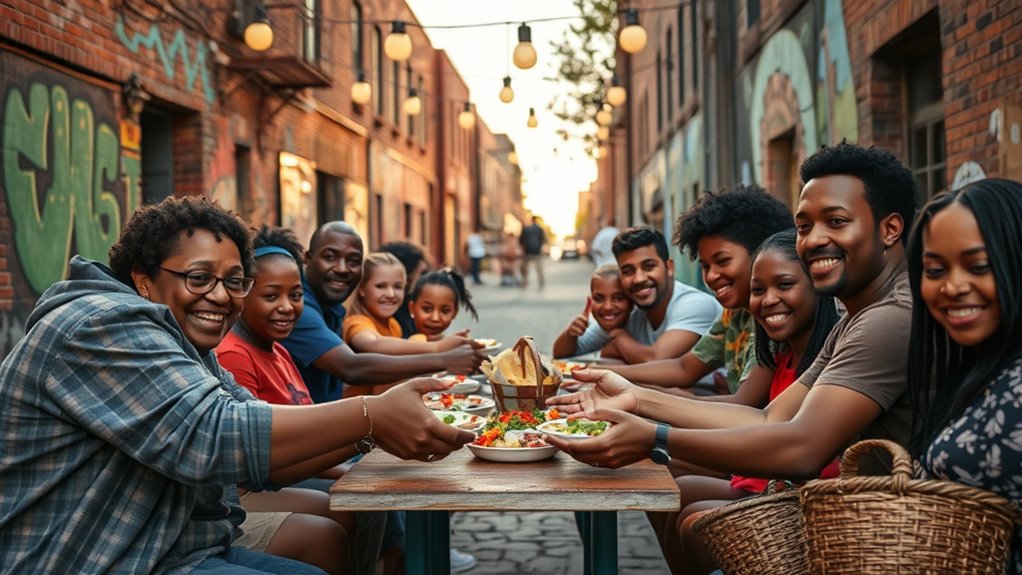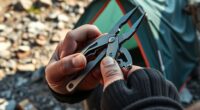To build mutual aid now, start by connecting with your neighbors and local groups through open conversations and social media. Identify shared needs like food, transportation, or emotional support, then organize regular meetups or activities to strengthen bonds. Keep communication consistent and inclusive, encouraging everyone’s contributions. Remember, ongoing efforts foster trust and resilience. If you want to learn more about creating a supportive community, keep exploring ways to foster collaboration and shared responsibility.
Key Takeaways
- Initiate open conversations with neighbors to identify shared needs and resources.
- Use local communication channels like social media and bulletin boards for outreach and updates.
- Foster ongoing relationships through regular community events, skill-sharing, and mutual support activities.
- Encourage everyone’s contributions, emphasizing trust, reciprocity, and inclusivity within the community.
- Establish quick-response structures for emergencies, ensuring collective resilience and continuous support.

Have you ever wondered what truly strengthens a community? It’s not just about shared spaces or common interests; it’s about the bonds you build and the trust you foster among neighbors. When people come together to support each other, especially in times of need, they create a resilient network that can withstand challenges. Mutual aid is a powerful way to cultivate this sense of connection. It’s not about charity or top-down assistance—it’s about neighbors helping neighbors, sharing resources, skills, and time to lift everyone up. This approach transforms individuals into a collective force capable of addressing local issues more effectively than any individual effort alone.
To start building mutual aid, you first need to recognize the value of community collaboration. Reach out to those around you—your neighbors, local organizations, or community groups—and express your intention to work together. Open conversations about what resources are available and what needs exist. Sometimes, just asking, “What can I do to help?” sparks relationships that might have never formed otherwise. You’ll find that many people are enthusiastic to contribute, whether it’s through sharing food, offering transportation, babysitting, or providing emotional support. The key is to create an environment where sharing feels natural and valued, not burdensome.
Creating a mutual aid network also involves clear communication. Use simple tools like neighborhood social media pages, group chats, or community bulletin boards to coordinate efforts. Keep everyone informed about upcoming needs or events. When someone faces a crisis—a health issue, job loss, or natural disaster—the community can step in quickly if there’s already a structure in place. This responsiveness makes a tangible difference in people’s lives, reducing feelings of isolation and helplessness. It also fosters a sense of belonging, showing that no one has to face hardships alone.
You should also think about sustainability. Mutual aid isn’t just a one-time effort; it’s about cultivating ongoing relationships. Regular check-ins, community dinners, or skill-sharing workshops can strengthen bonds and keep the network active. As trust builds, people become more willing to share their vulnerabilities and ask for help. Remember, mutual aid is rooted in reciprocity—giving and receiving become seamless parts of community life. When everyone participates, the collective capacity to address challenges grows, making your neighborhood more resilient and connected.
Ultimately, building mutual aid is about recognizing that everyone has something to offer. When you prioritize community over isolation, you create a place where everyone feels seen, supported, and empowered. This collective approach not only addresses immediate needs but also lays the foundation for a stronger, more compassionate community in the long run. Recognizing the importance of community collaboration can greatly enhance the effectiveness of these efforts.
Frequently Asked Questions
How Can I Start a Mutual Aid Group in My Neighborhood?
To start a mutual aid group in your neighborhood, begin by talking to neighbors to gauge interest and identify needs. Use social media or community boards to spread the word. Organize a meeting to discuss goals, assign roles, and plan activities. Keep communication open, foster trust, and be inclusive to encourage participation. Your proactive effort can create a supportive network that addresses local needs effectively.
What Are Common Challenges in Building Community Networks?
Building community networks can feel like juggling, with challenges like trust issues, limited resources, and differing priorities. For example, when I started my neighborhood group, some neighbors hesitated, unsure if it would work. You might face similar hurdles, but persistence and open communication help. Remember, even small acts create ripples—over time, trust grows, and your network becomes a sturdy web of support, ready to uplift everyone.
How Do Mutual Aid Groups Sustain Long-Term Participation?
You keep mutual aid groups thriving long-term by fostering strong relationships and clear communication. Encourage members to share responsibilities and recognize their contributions, which builds commitment. Regular meetings, transparent decision-making, and celebrating successes help maintain motivation. Address challenges openly and adapt to members’ needs. By creating a sense of belonging and emphasizing collective impact, you guarantee sustained participation and a resilient, supportive community that endures over time.
What Legal Considerations Should I Be Aware Of?
You should be aware of local laws regarding liability, permits, and insurance to protect your group. Registering as a nonprofit or community organization can offer legal protections and access to grants. Keep clear records of meetings, decisions, and finances to guarantee transparency. Additionally, understand privacy laws when handling personal information, and consult legal professionals if you’re unsure about compliance. Staying informed helps your mutual aid group operate safely and sustainably.
How Can Digital Tools Enhance Community Collaboration?
Imagine if you could harness a time machine—digital tools can do just that for your community. You can use social media, messaging apps, and collaborative platforms to organize efforts, share resources, and build trust quickly. These tools make communication instant and transparent, helping you coordinate events and identify needs efficiently. Embracing digital technology strengthens your mutual aid network, ensuring everyone stays connected and supports each other, especially during challenging times.
Conclusion
Remember, building a stronger community takes time and effort, but it’s worth it. By lending a hand, sharing resources, and fostering genuine connections, you create a safety net that benefits everyone. Don’t wait for change to happen—be the spark that ignites a supportive environment. After all, a rising tide lifts all boats, so put your shoulder to the wheel and help turn the tide in your neighborhood. Together, you can make a real difference.










